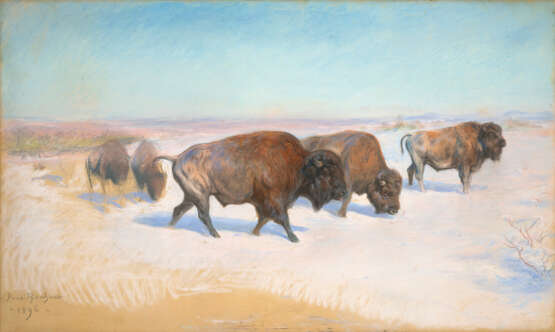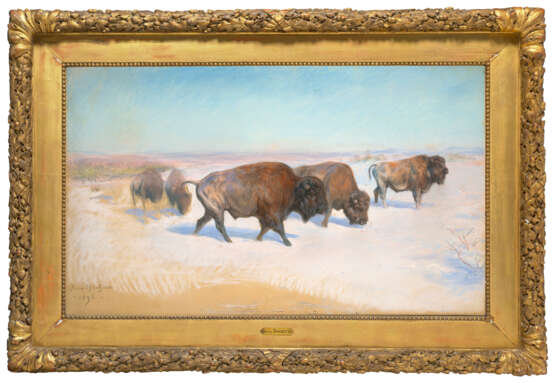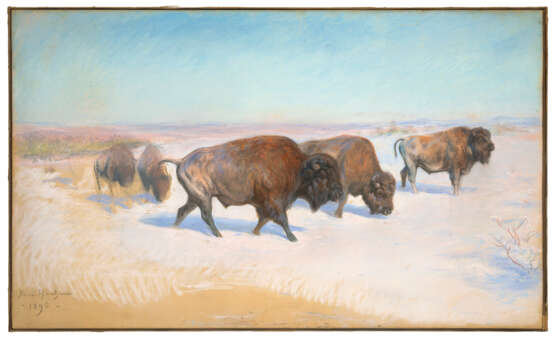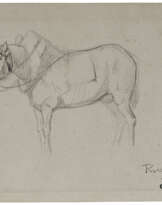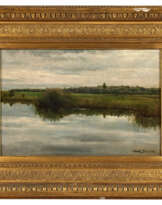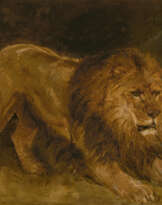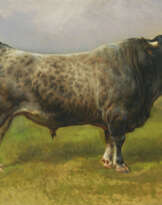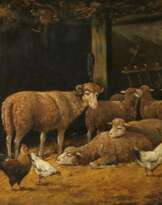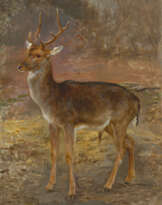ID 1172962
Lot 123 | ROSA BONHEUR (BORDEAUX 1822-1899 THOMERY)
Estimate value
€ 100 000 – 150 000
L’Émigration des bisons
signé (?) et avec datation ‘Rosa Bonheur / - 1896 -’ (en bas à gauche)
pastel sur papier beige
57 x 94,5 cm (22 3⁄8 x 37 ¼ in.)
Provenance
Emile-Jean-Albert Soubies (1846-1918), puis par descendance au propriétaire actuel.
Further details
ROSA BONHEUR, STUDY FOR THE MIGRATION OF THE BISONS, PASTEL ON LIGHT BROWN PAPER, SIGNED AND DATED 1896
Rosa Bonheur’s interest in bison dates back to the last two decades of her career, when – although she had never visited the United States – her popularity was growing with American dealers and critics. In 1889, while visiting the Exposition Universelle in Paris, she met William F. Cody (1846-1917), known as Buffalo Bill. For seven months, the latter presented a larger-than-life, pay-what-you-can show on the Neuilly plain outside Paris, entitled Wild West Show, featuring real cowboys, Native Americans and wild animals, including bison, intended to illustrate the struggles between natives and white settlers (Rosa Bonheur (1822-1899), exhib. cat., Bordeaux, Galerie des Beaux-Arts, Barbizon, Musée de l’École de Barbizon, and New York, Dahesh Museum, 1997-1998, p. 72). Already popular in America, this show fuelled the European imagination and fascination with the expansion of the American West. The show attracted many French artists, including Paul Gauguin and Rosa Bonheur (E. C. Burns, ‘Les artistes français et les Amérindiens à la fin du XIXe siècle’, in Le Scalp et le Calumet. Imaginer et représenter l'Indien en Occident du XVIe siècle à nos jours, exhib. cat., La Rochelle, Musées d’Art et d’Histoire, 2017, pp. 158-169).
In September 1889, Rosa Bonheur took the opportunity to visit the show’s Native American encampments and share meals with their chiefs. She made numerous drawings and sketches of people and live bison. She also painted an equestrian portrait of Buffalo Bill, now preserved at the Buffalo Bill Center of the West in Cody, Wyoming (inv. Coe. 8.66). In addition to the works produced on site, Bonheur’s presence is attested by a photograph: the artist, seated in the centre, is surrounded by Buffalo Bill and actors from the Wild West Show (S. Buratti-Hasan and L. Jarbouai, Rosa Bonheur (1822-1899), exhib. cat., Bordeaux, Musée des Beaux-Arts, and Paris, Musée d’Orsay, 2022-2023, pp. 224-225).
Among Bonheur’s works inspired by the American West, the bison series testifies to her fascination with this animal. The studies of 1889 show her desire to study the living model (Château de Rosa Bonheur, By-Thomery inv. SE-07, MDPB 2020.1.85). She also requested information and sketches of bison from the American painter Albert Bierstadt, who was in Paris in 1889 (A. Klumpke, Rosa Bonheur, sa vie, son œuvre, Paris, 1908, p. 46). To best represent the vegetation of the West, she obtained ‘buffalo grass’, from her American friend and artist, Anna Klumpke, who also helped nurture the artist’s attraction to the American West (Klumpke, op. cit., p. 15-26). All this research culminated in two major works from the very end of her career: the present pastel study, and a painting on canvas of the same subject, where the herd of bison is much larger and occupies the entire surface of the composition (fig. 2; location unknown; Coeur d’Alene Art Auction, Hayden, Idaho, 27 July 2019, lot 248). Annie-Paule Quinsac believes that the present pastel is a riccordo of this painting rather than a preparatory study, and that the signature and dating were probably added later. She also notes the rarity of this pastel: ‘an exception for its size in Bonheur’s corpus’ (written communication, 15 February 2024).
The culmination of a long development process, The Migration of Bison is a symbol of a free America. Rosa Bonheur represents the liberation of the bison from their ranch to return to their natural habitat on the Great Plains, considered sacred ground. She refused to see nature damaged or transformed by modernisation, and focused all her attention on the animals and peoples whose extinction she feared would result from change.
This pastel, which has remained in the same family since its purchase during the artist’s lifetime, belonged to Emile-Jean-Albert Soubies (1846-1918), lawyer and music critic, and author of numerous books on the history of music and theatre in the late 19th century. He was named Chevalier de la Légion d’honneur in 1893, a few years before Bonheur painted the pastel.
| Artist: | Rosa Bonheur (1822 - 1899) |
|---|---|
| Applied technique: | Painted, Pastel, Pastel on paper |
| Art style: | Old Masters |
| Place of origin: | Western Europe, France, Europe |
| Auction house category: | All other types of objects, Paintings, Watercolors, Drawings, Drawings, Watercolors and drawings |
| Artist: | Rosa Bonheur (1822 - 1899) |
|---|---|
| Applied technique: | Painted, Pastel, Pastel on paper |
| Art style: | Old Masters |
| Place of origin: | Western Europe, France, Europe |
| Auction house category: | All other types of objects, Paintings, Watercolors, Drawings, Drawings, Watercolors and drawings |
| Address of auction |
CHRISTIE'S 9 Avenue Matignon 75008 Paris France | ||||||||||||||
|---|---|---|---|---|---|---|---|---|---|---|---|---|---|---|---|
| Preview |
| ||||||||||||||
| Phone | +33 (0)1 40 76 85 85 | ||||||||||||||
| Fax | +33 (0)1 40 76 85 86 | ||||||||||||||
| Conditions of purchase | Conditions of purchase | ||||||||||||||
| Shipping |
Postal service Courier service pickup by yourself | ||||||||||||||
| Payment methods |
Wire Transfer | ||||||||||||||
| Business hours | Business hours
|
